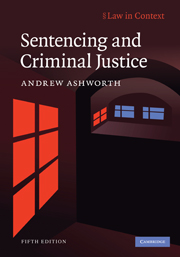Book contents
- Frontmatter
- Contents
- Preface
- Table of legislative measures
- Table of cases
- 1 An introduction to English sentencing
- 2 Sentencing and the constitution
- 3 Sentencing aims, principles and policies
- 4 Elements of proportionality
- 5 Aggravation and mitigation
- 6 Persistence, prevention and prediction
- 7 Equality before the law
- 8 Multiple offenders
- 9 Custodial sentencing
- 10 Non-custodial sentencing
- 11 Procedural issues and ancillary orders
- 12 Special sentencing powers
- 13 Conclusions
- Appendix: The Sentencing Council: provisions in the Coroners and Justice Act 2009
- References
- Index
4 - Elements of proportionality
Published online by Cambridge University Press: 05 June 2012
- Frontmatter
- Contents
- Preface
- Table of legislative measures
- Table of cases
- 1 An introduction to English sentencing
- 2 Sentencing and the constitution
- 3 Sentencing aims, principles and policies
- 4 Elements of proportionality
- 5 Aggravation and mitigation
- 6 Persistence, prevention and prediction
- 7 Equality before the law
- 8 Multiple offenders
- 9 Custodial sentencing
- 10 Non-custodial sentencing
- 11 Procedural issues and ancillary orders
- 12 Special sentencing powers
- 13 Conclusions
- Appendix: The Sentencing Council: provisions in the Coroners and Justice Act 2009
- References
- Index
Summary
This chapter explores the practical application of the proportionality principle in English sentencing. After examining the relevant statutory provisions, we begin an exploration of the concept of proportionality in practice and in theory. Part 4.2 considers people's opinions about the relative seriousness of different offences, and part 4.3 discusses a possible theoretical framework for determining questions of offence-seriousness. Part 4.4 relates this framework to a selection of English offences: most of these are now the subject of guidelines, and one question will be how the guideline structure interprets proportionality. In part 4.5 we consider the variations in culpability, and part 4.6 presents some provisional conclusions on the elements of proportionality.
The proportionality principle
In 1990 the Home Office left no doubt that the intention behind the reforms which became the Criminal Justice Act 1991 was to introduce ‘a new legislative framework for sentencing, based on the seriousness of the offence or just deserts’. Arguing that both rehabilitation and deterrence have drawbacks as purposes of sentencing, the White Paper asserted that
If the punishment is just, and in proportion to the seriousness of the offence, then the victim, the victim's family and friends, and the public will be satisfied that the law has been upheld and there will be no desire for further retaliation or private revenge.
As noted in Chapter 3.5 above, the 1991 Act failed to convey this message clearly, and led to some confusion.
- Type
- Chapter
- Information
- Sentencing and Criminal Justice , pp. 104 - 155Publisher: Cambridge University PressPrint publication year: 2010



